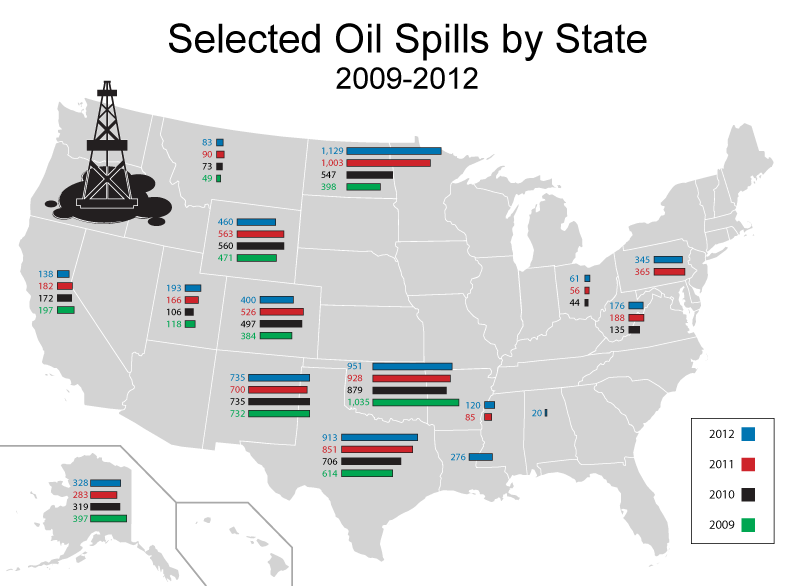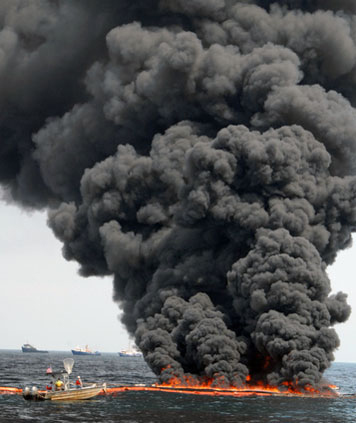“The U.S. Environmental Protection Agency published a rule on January 9, 2014 requiring oil and gas companies using hydraulic fracturing off the coast of California to disclose the chemicals they discharge into the ocean. Oil and gas companies have been fracking offshore California for perhaps as long as two decades, but they largely flew under the radar until recently. An Associated Press story in August 2013 revealed that oil and gas companies had engaged in hydraulic fracturing at least a dozen times in the Santa Barbara Channel – the site of the nation’s first offshore drilling site as well as the first major oil spill. The 1969 well blowout in the Santa Barbara Channel became the impetus for a series of environmental laws such as the National Environmental Policy Act and the Clean Water Act” (source).
Meanwhile, West Virginia continues to suffer from a recent chemical spill in the Elk River. “The disastrous impact of mining on West Virginia’s water resources goes back generations and could soon render much of the state’s water undrinkable, activists and experts say. Officials on Monday started lifting the ban on tap water prompted by last week’s chemical spill in the Elk River. About 300,000 people in nine counties have been unable to use their water other than to flush toilets for the past five days.
Experts, however, say the problem goes much deeper, and that coal mining made many wells and streams useless years ago. “For more than a century, the coal industry has had pretty much free rein to do whatever it wants,” said Vivian Stockman, spokeswoman for the Ohio Valley Environmental Coalition. Stockman points to a common coal-industry practice: pumping chemical-laden wastewater directly into the ground, where it can leech into the water table and turn what had been drinkable well water into a poisonous cocktail of chemicals. “All this waste is going underground for years, and then one day people start noticing their well water turning sometimes orange, sometimes black. The water stinks” ” (source – also see the following commentary).
“A new poll released Oct. 11 found that a majority of Americans want the federal government to require facilities to use safer chemicals and processes to prevent chemical disasters like the explosion in West, TX in April. However, an effort to better coordinate the work of three federal agencies was stalled thanks to the government shutdown. Now that the agencies are all functioning again, we hope they will meet their target deadlines for recommending new policies to improve the safety of facilities handling or storing large quantities of hazardous chemicals” (source).
“The latest data on chemical storage risks shows that over 50 billion pounds of toxic and flammable chemicals are stored at 12,761 facilities nationwide. As the tragic explosions at the West, TX fertilizer plant and a Geismar, LA chemical plant have demonstrated, these facilities pose serious threats to workers and communities throughout the country. The distribution of high-risk chemical facilities – i.e., those that handle significant quantities of 140 dangerous chemicals – are available at a website the Center for Effective Government created and maintains through the Right-to-Know Network” (RTKNET.org) (Ibid.).
“The Spills and Accidents database contains data on toxic chemical spills and other accidents reported to the National Response Center (NRC). This database used to be called ERNS, the Emergency Response Notification System, and is still referred to as ERNS in many situations. Spills and Accidents data available on RTK Net are updated as of January 16, 2013, and include incidents from 1982 through 2012. Incidents reported to NRC range from minor to serious, from an oil-sheen on water to a release of thousands of gallons. NRC reports are extensive, but also known to be incomplete, as many incidents are never reported, and those that are reported generally are not subject to verification” (Ibid.). Cold comfort.





